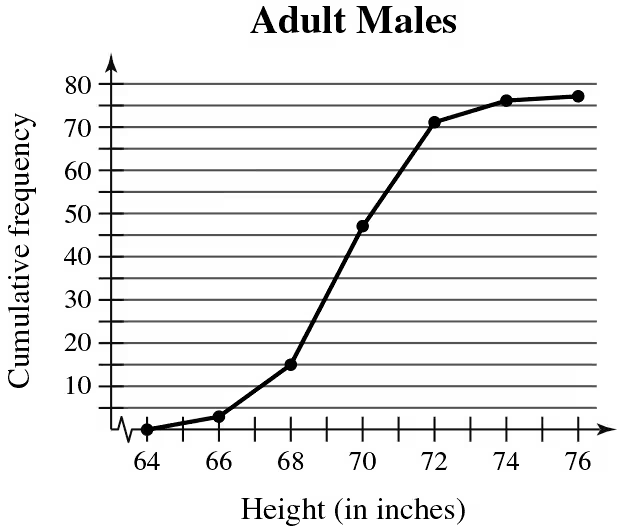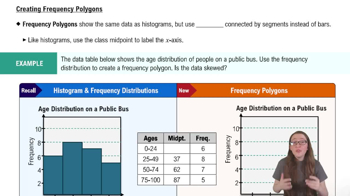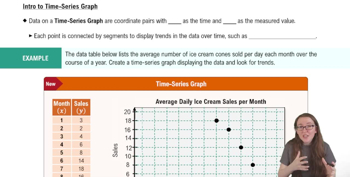Hershey Kisses Refer to Data Set 38 “Candies” and use the weights (grams) of Hershey’s Kisses. Begin with a lower class limit of 4.300 g and use a class width of 0.100 g. Does this distribution appear to be a normal distribution?
Table of contents
- 1. Intro to Stats and Collecting Data1h 14m
- 2. Describing Data with Tables and Graphs1h 55m
- 3. Describing Data Numerically2h 5m
- 4. Probability2h 16m
- 5. Binomial Distribution & Discrete Random Variables3h 6m
- 6. Normal Distribution and Continuous Random Variables2h 11m
- 7. Sampling Distributions & Confidence Intervals: Mean3h 23m
- Sampling Distribution of the Sample Mean and Central Limit Theorem19m
- Distribution of Sample Mean - Excel23m
- Introduction to Confidence Intervals15m
- Confidence Intervals for Population Mean1h 18m
- Determining the Minimum Sample Size Required12m
- Finding Probabilities and T Critical Values - Excel28m
- Confidence Intervals for Population Means - Excel25m
- 8. Sampling Distributions & Confidence Intervals: Proportion1h 12m
- 9. Hypothesis Testing for One Sample3h 29m
- 10. Hypothesis Testing for Two Samples4h 50m
- Two Proportions1h 13m
- Two Proportions Hypothesis Test - Excel28m
- Two Means - Unknown, Unequal Variance1h 3m
- Two Means - Unknown Variances Hypothesis Test - Excel12m
- Two Means - Unknown, Equal Variance15m
- Two Means - Unknown, Equal Variances Hypothesis Test - Excel9m
- Two Means - Known Variance12m
- Two Means - Sigma Known Hypothesis Test - Excel21m
- Two Means - Matched Pairs (Dependent Samples)42m
- Matched Pairs Hypothesis Test - Excel12m
- 11. Correlation1h 6m
- 12. Regression1h 50m
- 13. Chi-Square Tests & Goodness of Fit1h 57m
- 14. ANOVA1h 57m
2. Describing Data with Tables and Graphs
Frequency Distributions
Problem 2.1.26a
Textbook Question
use the ogive to approximate
the number in the sample.

 Verified step by step guidance
Verified step by step guidance1
Step 1: Understand the ogive graph. An ogive is a cumulative frequency graph that shows the total number of observations below a certain value. In this case, the graph represents the cumulative frequency of adult males' heights in inches.
Step 2: Identify the highest cumulative frequency on the graph. The highest point on the ogive corresponds to the total number of observations in the sample. In this graph, the cumulative frequency reaches 80 at the height of 76 inches.
Step 3: Approximate the total sample size. Since the cumulative frequency at the highest point represents the total number of individuals in the sample, the total sample size is approximately 80.
Step 4: Verify the interpretation. Ensure that the cumulative frequency values increase consistently and that the graph ends at the total sample size. This confirms the ogive is correctly interpreted.
Step 5: Use the ogive for further analysis. You can use the graph to determine the number of individuals below specific height thresholds or calculate proportions within certain ranges.
 Verified video answer for a similar problem:
Verified video answer for a similar problem:This video solution was recommended by our tutors as helpful for the problem above
Video duration:
1mPlay a video:
Was this helpful?
Key Concepts
Here are the essential concepts you must grasp in order to answer the question correctly.
Ogive
An ogive is a graphical representation of cumulative frequency, which shows the number of observations that fall below a particular value in a dataset. It is constructed by plotting cumulative frequencies against the upper boundaries of the class intervals. The resulting curve helps in understanding the distribution of data and can be used to estimate the number of observations within specific ranges.
Cumulative Frequency
Cumulative frequency is the running total of frequencies in a dataset, which indicates how many observations fall below or at a certain value. It is calculated by adding the frequency of each class interval to the sum of the frequencies of all preceding intervals. This concept is essential for constructing ogives and helps in analyzing the distribution of data over a range.
Recommended video:

Creating Frequency Polygons
Interpreting Graphs
Interpreting graphs involves analyzing visual data representations to extract meaningful information. In the context of an ogive, one must understand how to read the axes, identify key points, and determine cumulative frequencies at specific heights. This skill is crucial for making approximations and drawing conclusions based on the graphical data presented.
Recommended video:

Creating Time-Series Graphs

 6:38m
6:38mWatch next
Master Intro to Frequency Distributions with a bite sized video explanation from Patrick
Start learningRelated Videos
Related Practice
Textbook Question
